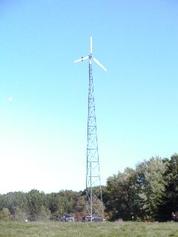Wind Basics

Wind turbines come in all sizes, from those with rotors measuring a few feet across to those with rotors hundreds of feet in diameter.
Household wind systems have rotors up to perhaps 25 feet in diameter, and can be an attractive choice if you live in a windy area or have high electricity prices The economics of a home system can be substantially improved if:
Household wind systems have rotors up to perhaps 25 feet in diameter, and can be an attractive choice if you live in a windy area or have high electricity prices The economics of a home system can be substantially improved if:
- Your state has a net metering law that requires your utility to credit any excess electricity you generate and feed to the utility system against any electricity you use during times when winds are low.
- You have a farm, an all-electric home, or some other situation that makes your electricity consumption higher than normal, so that most or all of the wind turbine's output can be used on site.
Applications
Wind turbines can be used:
· As stand alone systems
· Connected to utility grid with or without a battery back-up system
· In combination with photovoltaics (solar panels) to form a hybrid system
· As distributed power generators
· As stand alone systems
· Connected to utility grid with or without a battery back-up system
· In combination with photovoltaics (solar panels) to form a hybrid system
· As distributed power generators


